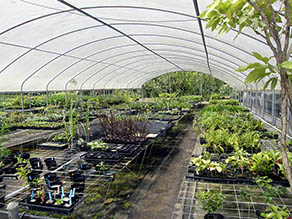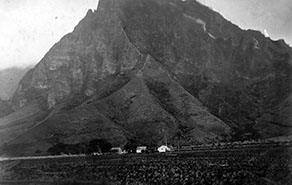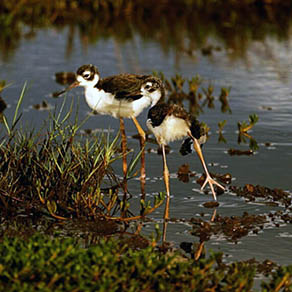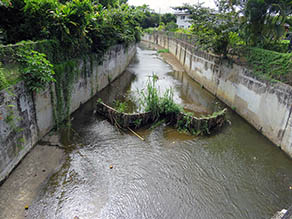 |
 |
 |
 |
||||||
|
|
|
|
|
|
|
|
|
|
|
| People | Environment | Losing Land | Development | Sovereignty | Language | Sources & Links | |||||||||
 |
|
 |
|||||||
 |
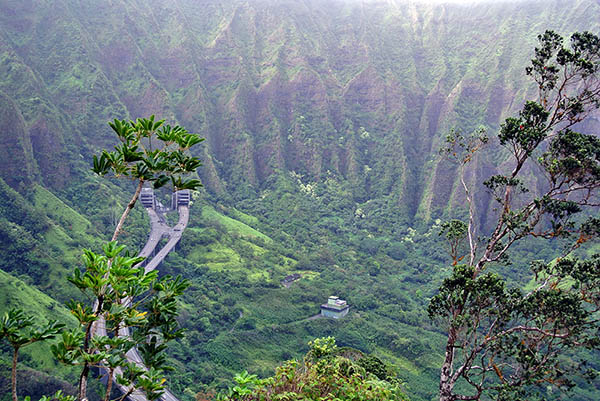
“The top of the summit looks relatively the same,” Rick says. “The plant life there is pretty much intact. So from the top of the mountains, pristine. And then because there’s such a vertical drop within this valley, it’s pretty steep valley walls, the change in vegetation is pretty drastic. It goes from pristine to crap in an instant. And everything down below has been altered. I would say less than .05% of native vegetation remains in the bottom of the valley today. 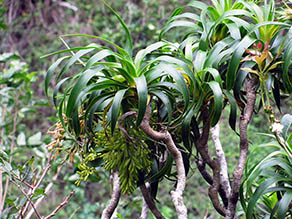
“Now you can’t find any loulu palms in the lowlands today hardly anywhere, but you can still see remnant pockets of them up on the cliff side over here. You can still find a few pockets of ‘ōhi‘a lehua left today down here. And the majority of the plants that we propagate here in our nursery are from those trees. I take cuttings off of them, grow those out. We plant them all over on our non-profit side. Now, those plants become our stock so that we don’t have to go up to collect the plants anymore, same with these loulu palms. "There’s still a halapepe right there. It’s below the elevation of the freeway. That’s back there, so that’s actually a really good sign. And then some of the ground covers. You can see lots of hapu‘u from the H-3, but you gotta watch out. There’s a ton of Australian tree fern, and then there’s also a ton of Mule’s Foot fern. There’s still a few hapu‘u and there’s actually quite a few ‘ama‘u ferns up there. And then of course, uluhe in this drier side. You see a few ko‘oko‘olau. You see some akia kuahiwi, ‘ūlei. I saw some maile a little bit further back. Like I said, it’s still there, but literally .05% of the biomass in this valley is native. 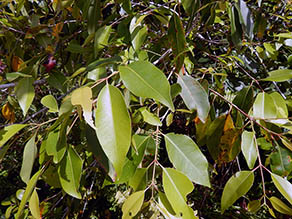
“I think Java plum is one of the trees that, if we remove them, could have a significantly positive impact in Hawai‘i as far as aquatic systems go. They have an extremely high rate of evapotranspiration. And every valley, wet valley, is choked out with them. Every stream, riparian section on the streams, it was choked out with them. “If we remove those, I think there would be a lot more water in our streams. Same with cinnamon. Tons of cinnamon back here. Java plums, cinnamon, and then your typical strawberry guava, guava, and there’s a plant called bingabing that’s back here, Macaranga is the genus. It’s another horrible one. They’ve also documented miconia back here. Small populations, but thankfully the O‘ahu Invasive Species Committee is out here doing routine annual checkups to see if there’s any more offspring. Rick tells a story about stream restoration in Waimānalo “There’s schefflera everywhere. Schefflera is a bad one. And it sucks because all of the native plants within that same family, which is araliaceae are gorgeous. That’s actually one of the trees that you can still see up there in the wet area near the summit, is ‘ohe mauka or ‘ohe‘ohe it’s called. It used to be Tetraplasandra oahuensis, but then they changed it; now it’s Polyscias oahuensis. Gorgeous trees. 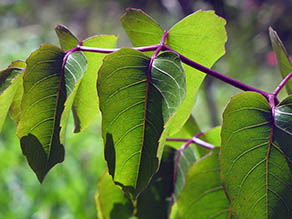
“And then there’s ‘ohe makai which used to be Reynoldsias, but now it’s also polyscias. They all got grouped under polyscias, which is stupid. You can put that on record. I’m so upset with the taxonomical change of our native araliaceae plants. But yeah, schefflera is a huge problem but easily defeatable because the wood is so soft and you can cut those down really quickly. And they tend not to come back after you cut them down at the base. Read about invasive species issues at the Ha‘ikū Steps “Another one that’s really bad, and that’s going to take over everything is trema, the gunpowder tree. Gunpowder tree is so bad now. It’s going to be as bad as albizias, if not worse. Albizia tends to like to be able to shade out itself. Tremas don’t do that. They just get as big as albizias. but however many seeds an albizia tree can drop, a trema tree can probably drop 100 times more seeds. It’s unbelievable. “The seeds of a trema are the size of sand grain, and one tree in a season, I mean, you got an 80 foot tall tree with a hundred-foot canopy spread, and that thing drops millions of seeds. Oh man, that’s a nightmare. When we first started to do our restoration work out here, we cut down all of these big canopy trees, and then like a carpet the trema came up, because there’s this stored seed bank of millions upon millions of seeds that’s just waiting for their opportunity to shoot up. And once we removed those canopies, man, they just all came up. It was gnarly.” “I feel like native plant restoration and education were the two pillars of our beginning,” Keoni reflects, “native plants, and education and culture. And that just comes from the interests of the three of us that started the program. The native plant nursery, Hui Kū Maoli Ola, is located on the bottom, makai corner of the parcel that we’re on. And I believe that they are the largest native plant nursery in Hawai‘i. They’ve been going for 15-20 years, for quite a while. They do large restoration projects across the islands and as well as on our ‘āina in He‘eia as well. “Rick Barboza and Kapalikū Schirman are co-owners. Kapalikū also works for our nonprofit, part-time. Rick lives on the property, at the nursery. Our board is largely made up of residents of He‘eia, or they’re from a neighboring ahupua‘a. We’re place-based and being rooted in a place is really important to how we even understand ourselves, and how knowledge is generated, and our kuleana is involved in place.” Rick tells the origins of Hui Kū Maoli Ola “All of this was pineapple,” Rick says, “this whole area got turned into pineapple after that. So, that changed. And then when all of the taro patches were abandoned, rice came in, just like all the other places that were affected by plantation change.” “It had always been in taro lands,” Kanekoa says, “and then it went into rice. While it was in taro and converting to rice, you see the hillsides above us into the left were all in sugarcane and pineapple. When you plant pineapple on this side of the island with the amount of rain that it gets and don’t follow the elevational gradients and just basically plant it, it just created a lot of rivers. "And those rivers created a lot of sediment, which then flowed into the ponds. It created massive deforestation, and the deforestation created a lot of erosion. So probably when they were moving in the 30s and 40s, they were facing all kinds of issues with runoff from above. I could only imagine how it affected their ability to grow taro here. “The remaining native birds have pretty much evolved with taro. When you open up taro patches, they’ll come and nest. The ae‘o and then ‘ālae ‘ula, we finally have them here again. So just in the process of getting this land healthy. And then obviously, as our people start to farm it again, other ways of staying healthy.” Kanekoa talks about raising sheep at the lo‘i “You walk out and you see our native birds,” Keahi elaborates, “and that to me that’s something great because—in my opinion—a lot of places in our islands are not being able to be restored because of the birds. It’s because they think a lot of times there’s going to be an adverse effect on the birds of restoring some of these places. I think this is proof that when these types of places—the lo‘i and fish ponds are restored—that the native birds come back. And a lot of times old lo‘i grounds are now made into bird reserves, because there they are worried about those birds. “But I think most of us practitioners and people who do this are going to come with the respect to make sure those birds are safe. And on the flip side, these are way better environments once they are restored. This wall had thirty feet of mangrove growing on it. You wouldn’t have seen birds, you wouldn't see the ‘ulili or ‘ae‘o diving through the mangrove as we see it every day. "As we move farther down and cut the mangrove down, the birds follow us, they're happy to see the newly fresh-open ground. Right where we cut yesterday, there will be birds in there the next day picking around. “So those types of things I hope can happen in the future, because I know a lot of instances where because native birds are present, they don’t want it to be restored. And there’s a good backing to that because you never know if someone’s going to come in and totally just destroy habitats.” Dealing with mangrove at He‘eia fishpond “But one thing I’m realizing,” Keahi continues, “and we’re coming to more of an understanding—is if we aren’t farming these lands and if we’re not fishing from our seas, do we really care what happens to them? The people who do fish really care what happens to the ocean because it's a livelihood, right? Or when I’m driving on the streets and I see something probably shouldn’t be happening with the oil and gas and all these things going into the sewers, the storm drains directly actually affect our pond quality. 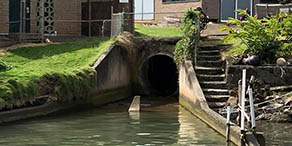
“Every fish pond and every ocean is affected by storm-drain quality because whether it runs into the river first, or the canals that we have made, it's going to make its way into the ocean. And so if I wash my car, I try to use more eco-friendly soap and I always do it on my grass, I’ll try to do it in a more appropriate way. Because I know what I’m doing. "It’s easy to just be like ‘Ah, it’s not that bad.’ But then you really start to think, ‘Yeah, I want to pull fish from this fish pond and I want to eat it, and I want to make sure that the quality of the water these fish are being raised in isn’t polluted and isn’t going to get into me if I eat these fish.’" Read about invasive jellyfish in He‘eia fishpond and Lā Holoholo: Predator eradication at He‘eia Fishpond “Kāne‘ohe was really thriving,” Emalia recalls, “maybe starting like right after all the subdivisions came in, when the fishponds were all filled in. We didn’t know all that was happening. We were just kids growing up. It’s changing so quickly. I think for us, because we’re the old-time residents here, we are sad that that’s happened because there’s been no respect for where our food provisions came from. There was just a hue and cry for better sewage services, which everybody uses, but there was no thought about whether Hawaiians were still bringing their food out of that bay. So all of a sudden you hear, ‘Oh they’re building something where the sewage is going to have an outfall go out into the bay.’” “The two terrestrial impacts are really, number one, the channelization of streams,” Hi‘ilei points out. “Pretty much Kāne‘ohe, He‘eia, Kahalu‘u, and then it’s not so channelized beyond that. Just this whole south-central bay is heavily sedimented because of the speed of water. Whenever there’s a flood, it’s just like chocolate milk, and then the corals and the reefs suffer as a result of it. “The other challenge is not so much south and central, but pretty much Kahalu‘u, a little bit in He‘eia, but Kahalu‘u as you go up north: there is no sewer. The residents aren’t hooked up to the sewer line. There’s people that live there, but it’s not a full-on residential area once you pass Ka‘alaia. People have septics, people have cesspools. Whenever there’s a big flood, a big rain, the ground saturates and then the system is unable to process that. And so, the spillover is in the bay. When there’s big floods, you’ll see it everywhere. Kailua will get it, Waikiki will get it. You’ll see that certain beaches will be closed because the sewage effluent outfall. 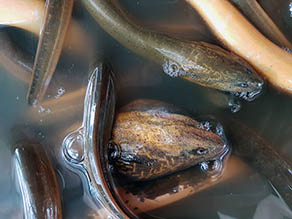
“We believe that within our stream channels, the grass shrimps and the armored catfish came from the plantations. And also, the dojo, those little eel-looking things, and then rice patty eels. We have rice patty eels in our taro patches. It kind of freaks people out. These are introduced freshwater eels. They’re actually really delicious, it’s like unagi. Good to eat. Really scary-looking when you step on them; not something that you really want to run into because they live in the mud, so you don’t know that they’re there until you actually step on them. Or when you pull out a big kalo and you see them come out, you’re like, ‘What?!’ It’s crazy.” “When we talk about fishing and the depletion of resources, it’s not just one thing,” Hi‘ilei continues. “You can’t point a finger in one place. It’s a combination of everything. I think, yes, environmental changes, introduction of invasive species; there’s seaweed that has been introduced, there’s fish that have been introduced, there’s the military that lives over there, there’s people. There’s a definite increase in the population and users of this bay.”
|
 |
|
 |
The people and environment of He‘eia provide the setting for the contemporary issues facing this community. The first of these is losing land.
|
 |
||
 |
|
 |
||

|
 |
||||
|
||||
Copyright 2019 Pacific Worlds & Associates • Usage Policy • Webmaster |
||||
